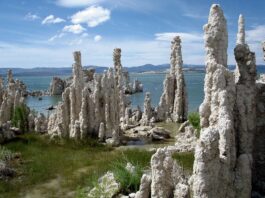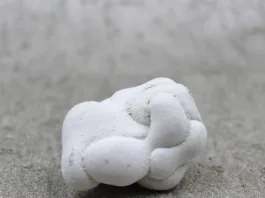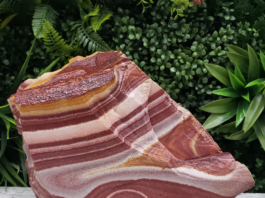Travertine is a type of sedimentary rock that is formed by the precipitation of carbonate minerals from groundwater. It is often found in and around hot springs, caves, and limestone deposits. The primary mineral that makes up travertine is calcite, and the rock has a distinctive appearance characterized by its porous nature and a variety of earthy colors, including shades of white, cream, tan, and rust.


Key characteristics of travertine include its ability to take a high polish, making it a popular choice for decorative and architectural applications. It also exhibits unique patterns and textures due to the presence of mineral impurities and the way it forms through the deposition of minerals from flowing water.
Geological Formation:
Travertine forms through a process known as precipitation, where minerals dissolve in water and are later deposited as the water evaporates. In the case of travertine, this typically occurs in limestone-rich areas where groundwater, carrying dissolved calcium carbonate, emerges to the surface. As the water evaporates, the calcium carbonate is left behind, leading to the gradual buildup of travertine deposits.
Hot springs are a common environment for travertine formation. The warm water brings calcium carbonate to the surface, and as the water cools and evaporates, the mineral precipitates, forming layers of travertine. Over time, these layers can accumulate and harden into the rock we recognize as travertine.

Historical Use and Significance:
Travertine has a rich history of use in construction and art. Its durability, versatility, and aesthetic appeal have made it a popular choice for various architectural and decorative purposes. Some notable historical uses include:
- Roman Architecture: Perhaps the most famous historical use of travertine is in ancient Roman architecture. The Colosseum, the Roman Forum, and various other structures were constructed using travertine. The consistency of color and the ability to carve intricate details made it a preferred building material.
- Italian Renaissance: During the Italian Renaissance, travertine experienced a resurgence in popularity. It was widely used by architects such as Michelangelo and Bernini in the construction of churches, palaces, and sculptures.
- Modern Architecture: Travertine continues to be a sought-after material in modern architecture. Its timeless appearance, versatility, and ability to complement various design styles make it suitable for flooring, countertops, facades, and other applications.
In summary, travertine is a unique and aesthetically appealing sedimentary rock with a history deeply intertwined with architecture and art. Its formation in geological settings and its enduring use in construction underscore its significance in both natural and human contexts.
Types of Travertine

Travertine comes in various types and classifications based on factors such as color, patterns, and finishes. Here are some common types of travertine:
- Classic Travertine: This type of travertine is characterized by its neutral and warm tones, usually ranging from beige to light brown. Classic travertine often features subtle variations in color and is known for its timeless and elegant appearance.
- Noce Travertine: Noce travertine is distinguished by its darker, richer tones, including shades of brown and walnut. The deeper coloration can add a sense of warmth and sophistication to spaces where it is used.
- Silver Travertine: Silver travertine is notable for its cool gray and silver hues. This type of travertine is often chosen for its contemporary and modern aesthetic, providing a sleek and stylish appearance.
- Yellow Travertine: As the name suggests, yellow travertine exhibits various shades of yellow, ranging from light to deep golden tones. This type of travertine can bring a bright and vibrant feel to interior or exterior spaces.
- Red Travertine: Red travertine is characterized by its reddish-brown coloration, which can range from subtle hints to more pronounced tones. The warm and earthy hues of red travertine make it a distinctive choice for various applications.
- Walnut Travertine: Walnut travertine features a blend of brown and beige tones, often with intricate patterns and veining. This type of travertine can add a touch of sophistication and depth to surfaces like countertops and flooring.
- Ivory Travertine: Ivory travertine is known for its light and creamy color palette, providing a sense of brightness and airiness. It is a popular choice for creating a clean and elegant look in both traditional and contemporary settings.
- Vein-Cut Travertine: In vein-cut travertine, the stone is cut parallel to the natural bedding planes, highlighting linear patterns and creating a sleek, modern appearance. This cut is often used for wall cladding and flooring.
- Cross-Cut Travertine: In contrast to vein-cut, cross-cut travertine is cut perpendicular to the bedding planes, resulting in a more varied and random pattern. This cut is often used to showcase the natural beauty and unique veining of the stone.
- Tumbled Travertine: Tumbled travertine undergoes a process that gives it a weathered and aged appearance. The edges are softened, and the surface is textured, providing a rustic and antique look. Tumbled travertine is commonly used for flooring and outdoor applications.
These types of travertine offer a range of options for architects, designers, and homeowners to choose from, allowing for flexibility in achieving different aesthetic preferences and design goals.
Quarrying and Extraction of Travertine

Extraction Process:
The extraction of travertine involves several steps, from locating suitable deposits to the actual removal of the stone. Here’s a general overview of the extraction process:
- Site Selection: Quarrying begins with the identification of suitable locations where travertine deposits are present. These locations are typically chosen based on the quality and quantity of the stone available.
- Exploration: Once a potential site is identified, geological surveys and exploratory drilling may be conducted to assess the quality, thickness, and extent of the travertine deposits. This helps in determining the viability of the quarry.
- Clearing and Stripping: Before extraction can begin, vegetation, soil, and overburden (unwanted materials covering the travertine deposit) are removed to expose the raw travertine.
- Drilling: Holes are drilled into the travertine deposit using specialized equipment. These holes serve as channels for explosives that will break the rock into manageable blocks.
- Explosive Charges: Explosives are strategically placed in the drilled holes. The controlled detonation fractures the travertine into blocks of a size suitable for further processing.
- Block Extraction: Once the travertine has been broken into blocks, heavy equipment such as excavators or front-end loaders is used to lift and transport the blocks to the processing area. The size and shape of the blocks depend on the quarry’s equipment and the intended use of the travertine.
- Transportation: Extracted blocks are transported from the quarry to processing facilities or directly to manufacturers and distributors. Transportation methods may include trucks, cranes, or conveyor belts.
- Processing: At processing facilities, the travertine blocks undergo various treatments. This may include cutting into slabs, honing, polishing, and finishing according to the desired product specifications.
- Waste Management: Throughout the extraction and processing stages, there is often a generation of waste material. Responsible quarries implement measures for waste management, including the reclamation of quarry sites and the recycling or proper disposal of waste materials.
Locations of Major Quarries:
Travertine is quarried in various regions around the world, and the choice of quarry can influence the characteristics of the stone. Some of the major locations for travertine quarries include:
- Italy: Italy has a long history of producing high-quality travertine. The country is known for its classic travertine varieties, and quarries are often found in regions such as Tuscany and Rome.
- Turkey: Turkey is a significant exporter of travertine, providing a range of colors and types, including noce, silver, and ivory travertine. Denizli and Afyon are among the key travertine-producing regions in Turkey.
- Iran: Iranian travertine is well-regarded for its quality and is exported to various parts of the world. Mahallat and Yazd are notable regions with travertine quarries.
- Mexico: Mexico is another producer of travertine, with quarries located in areas like Durango and Zacatecas.
- Peru: Travertine is also quarried in Peru, contributing to the global supply of this versatile stone.
- United States: Some domestic quarries in the United States, such as those in Texas and Arizona, produce travertine used in construction and design projects.
It’s important to note that the choice of quarry can impact the specific characteristics of the travertine, including color variations, patterns, and overall quality. Sustainable quarrying practices and environmental considerations are increasingly becoming important factors in the industry.
Properties of Travertine

Travertine possesses a set of physical and chemical properties that make it a popular and versatile material for various applications. Here are some key properties of travertine:
- Porosity: One of the defining characteristics of travertine is its high porosity. The stone is formed by the precipitation of minerals from water, creating a porous structure. This porosity can affect the stone’s ability to absorb liquids and may require the application of sealers to reduce staining.
- Durability: Travertine is generally durable, making it suitable for use in high-traffic areas. However, its durability can vary based on factors such as the type of travertine, the finish applied, and the specific application. Proper care and maintenance are essential to preserve its appearance and longevity.
- Density: Travertine has a moderate to high density, contributing to its strength and durability. The density can vary among different types of travertine, influencing factors such as load-bearing capacity and resistance to wear.
- Color Variation: Travertine exhibits a range of colors, including white, cream, beige, tan, brown, and rust. The specific coloration is influenced by the presence of minerals and impurities during the stone’s formation, providing designers and homeowners with a variety of aesthetic options.
- Veining and Patterns: Travertine often features natural veining, patterns, and textures that add character and uniqueness to each piece. These variations contribute to the stone’s aesthetic appeal and can be highlighted or minimized depending on the cutting and finishing processes.
- Polishability: Travertine has the ability to take a high polish, which enhances its visual appeal. The polishing process reveals the stone’s natural luster, giving it a smooth and glossy finish. This property makes travertine suitable for decorative applications such as countertops and flooring.
- Workability: Travertine is relatively easy to cut and shape, making it a favored material for intricate carvings and architectural details. Its workability allows for a variety of finishes, including polished, honed, tumbled, and brushed, each providing a distinct look and feel.
- Thermal Insulation: Travertine has natural thermal insulation properties, meaning it can help regulate temperature and maintain a comfortable environment. This characteristic makes it suitable for flooring in both indoor and outdoor spaces.
- Sustainability: Quarrying practices and the environmental impact of travertine extraction vary, but responsible practices can make travertine a sustainable choice. Some quarries implement measures to minimize environmental impact and rehabilitate the sites after extraction.
- Versatility: Travertine is a versatile stone used in various applications, including flooring, countertops, wall cladding, decorative elements, and outdoor landscaping. Its diverse range of colors and finishes allows for flexibility in design.
Understanding these properties is crucial for selecting the right type of travertine for specific applications and ensuring its long-term performance and aesthetic appeal.
Common Applications

Travertine’s versatility and aesthetic appeal make it a popular choice for a wide range of applications in both residential and commercial settings. Here are some common applications of travertine:
- Flooring: Travertine flooring is a popular choice for both indoor and outdoor spaces. Its natural variations in color and pattern create a unique and elegant look. It is commonly used in entryways, kitchens, bathrooms, living rooms, and outdoor patios.
- Countertops: Travertine countertops add a touch of sophistication to kitchens and bathrooms. The stone’s ability to take a high polish contributes to a smooth and glossy surface, making it both functional and aesthetically pleasing.
- Backsplashes: Travertine is often used as a backsplash material in kitchens and bathrooms. Its diverse colors and patterns can complement various cabinetry and countertop designs.
- Wall Cladding: Travertine can be used for wall cladding in both interior and exterior applications. It adds texture and visual interest to walls, creating a warm and inviting atmosphere. It is commonly used in living rooms, fireplaces, and accent walls.
- Fireplace Surrounds: The natural beauty of travertine makes it a popular choice for fireplace surrounds. Its ability to withstand heat, combined with its aesthetic appeal, enhances the overall design of living spaces.
- Bathroom Applications: Travertine is widely used in bathrooms for flooring, countertops, shower surrounds, and decorative elements. Its resistance to moisture and its elegant appearance make it a suitable choice for creating spa-like atmospheres.
- Outdoor Paving: Travertine is an excellent choice for outdoor paving applications such as patios, pool decks, and pathways. Its natural porosity allows for water drainage, and its thermal insulation properties make it comfortable for barefoot walking.
- Decorative Accents: Carved travertine is often used for decorative accents, including columns, balusters, moldings, and statues. Its workability allows for intricate designs that add a touch of artistry to architectural elements.
- Fountains and Water Features: Travertine’s ability to withstand water and its aesthetic appeal make it a popular material for fountains and other water features. The stone’s natural variations contribute to the visual interest of these installations.
- Outdoor Landscaping: In addition to paving, travertine is used in landscaping for features such as garden pathways, retaining walls, and decorative elements. Its natural appearance complements outdoor greenery and landscaping designs.
- Tabletops and Furniture: Travertine tabletops and furniture pieces are appreciated for their durability and timeless aesthetic. Coffee tables, dining tables, and other furniture items made from travertine can add a touch of sophistication to interior spaces.
- Commercial Spaces: Travertine is often used in commercial spaces such as hotels, restaurants, and office buildings. Its versatility, durability, and aesthetic appeal make it a suitable choice for creating welcoming and visually appealing environments.
When considering travertine for a specific application, factors such as the type of travertine, finish, and maintenance requirements should be taken into account to ensure optimal performance and longevity.
Case Studies
Several iconic buildings and spaces around the world feature the successful application of travertine, showcasing its versatility, aesthetic appeal, and durability. Here are a few notable examples:

- The Colosseum, Rome, Italy:
- Application: The Colosseum, a symbol of ancient Rome, is one of the most iconic structures constructed with travertine. The exterior features large travertine blocks, showcasing the stone’s durability and timelessness. The Colosseum’s travertine facade has endured for centuries, highlighting the stone’s longevity.
- The Getty Center, Los Angeles, USA:
- Application: The Getty Center, designed by architect Richard Meier, is a modern architectural masterpiece that extensively uses travertine. The exterior facades, walkways, and open spaces are adorned with travertine, creating a cohesive and visually striking ensemble. The travertine’s light color complements the modern design of the museum.
- The Trevi Fountain, Rome, Italy:
- Application: The Trevi Fountain, a Baroque masterpiece, is another example of travertine’s use in iconic landmarks. The fountain’s intricate sculptures and details are crafted from travertine, adding to the grandeur and elegance of the monument.
- Yale University, New Haven, USA:
- Application: The Sterling Memorial Library at Yale University features a Collegiate Gothic design and extensive use of travertine. The library’s facade, columns, and interior spaces showcase the stone’s ability to convey a sense of tradition and sophistication.
- Sabbioneta, Italy:
- Application: The town of Sabbioneta in Italy is a UNESCO World Heritage Site known for its well-preserved Renaissance architecture. Many buildings in Sabbioneta, including palaces and churches, feature travertine facades and details, contributing to the town’s historical charm.
- Sheikh Zayed Grand Mosque, Abu Dhabi, UAE:
- Application: The Sheikh Zayed Grand Mosque is a stunning example of Islamic architecture and design. The exterior of the mosque is adorned with white marble and various decorative elements, including travertine columns and flooring. The use of travertine contributes to the mosque’s grand and pristine appearance.
- The Getty Villa, Malibu, USA:
- Application: The Getty Villa, an educational center and museum dedicated to the study of the arts and cultures of ancient Greece, Rome, and Etruria, features extensive use of travertine. The villa’s architecture and landscaping evoke the classical period, and travertine is a key element in achieving this aesthetic.
- Palais des Papes (Palace of the Popes), Avignon, France:
- Application: The Palais des Papes, a medieval palace in Avignon, features travertine used in its construction. The stone contributes to the palace’s monumental appearance, and the combination of travertine and Gothic architecture creates a powerful visual impact.
These case studies highlight the enduring appeal and adaptability of travertine across different architectural styles and time periods. Whether used in ancient Roman structures, Renaissance palaces, or contemporary museums, travertine continues to be a favored material for creating iconic and visually striking spaces.






